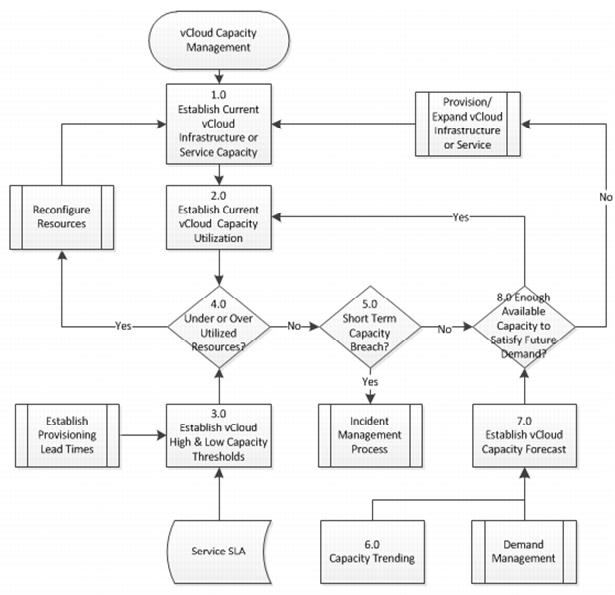8.2.1 Capacity Management Process Definition and Components
Historically, Capacity Management is usually performed when the system is implemented and covers the capacity requirements for the entire lifetime of the system. This creates enormous waste during the system’s early life because the excess capacity is not required until later, if at all. There is potential for enormous waste during the system’s entire lifecycle due to many other factors, such as over-estimation of usage or early retirement due to evolution of technology.
Even with virtualization, ensuring that sufficient capacity is readily available is always a concern. Virtualized environments manage capacity by reducing the contention for resources, usually by reducing the virtual machines-to-host ratio. This approach wastes resources as low ratios are adopted.
To make a vCloud implementation successful, resource waste is to be avoided. The Capacity Management process must become proactive and perform ongoing Capacity Management —the capacity configuration must be adjusted as conditions change—it is not sufficient to “set it and forget it.” By focusing on proactive Capacity Management, it is possible to increase the density of virtual machines on hosts. This enables the provider to realize the cost benefits of implementing a vCloud without compromising the services that run on it.
The following figure illustrates a high-level, proactive capacity management process. This process is applicable for both vCloud providers and tenants.
Though the proactive Capacity Management process looks the same as traditional Capacity Management process, the dynamic nature of the vCloud requires that the process be more agile and rely less on manual intervention. Manual Capacity Management may be appropriate in a physical infrastructure or during early virtualization adoption stages, but only tooling and automation can provide the proactive Capacity Management required for the vCloud.
Figure 15. High-Level Proactive Capacity Management Process
Long-term future capacity issues should be identified early so that the vCloud service is not impacted. With appropriate tooling, early warning is possible. Historical capacity usage behavior can be identified and combined with known future demand to provide a vCloud capacity forecast.
Short-term capacity breaches also need to be identified early so that remediation can be put in place to prevent compromising vCloud SLAs.
With this short-term and long-term knowledge, you can use automation to make the required resources available in the appropriate environment. For short-term breaches, automation can be used to identify underutilized resources in one environment and temporarily transfer them to an environment that is under-resourced. For long-term capacity issues, the automated provisioning process for new resources is predictable and well defined. This makes it possible to provision new resources such as hosts, clusters, or organization virtual datacenter capacity as required, without service breaches.
From a high level, the Capacity Management process involves:
1. Determining current capacity reserves.
2. Forecasting new requirements.
3. Planning for additional capacity.
Continuous improvement activities are critical to extracting the most value from your vCloud infrastructure. Results can be achieved through simple, periodic planning activities supported by regular capacity augmentation and operational day-to-day activities.

